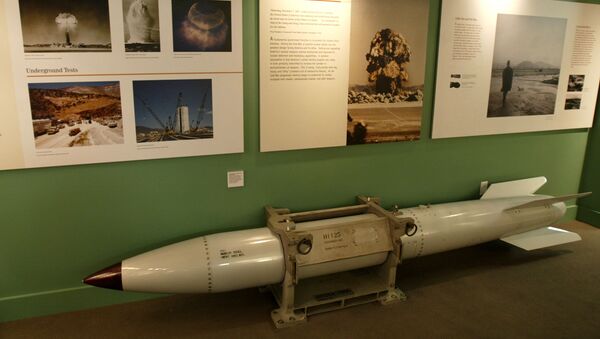The recent tests of the B61-12 gravity bomb, conducted by the National Nuclear Security Administration and the US Air Force on August 8, have sent a signal to Moscow, professor Hans Kristensen, director of the Nuclear Information Project at the Federation of American Scientists, told Radio Sputnik.
"Nuclear weapons are used to signal," Kristensen said. "The ones [deployed] in Europe now have been used to signal, from NATO's point of view, the defense of NATO against a potential attack from Russia and these new weapons, which will come to Europe in the early part of the next decade, will also serve that role."
The expert pointed out that the nuclear explosive power of the modernized B61-12 bomb is the same as that of its predecessor — B61, which is considered one of the main pillars of the US Air Force's nuclear arsenal.
More importantly, the modified bombs are due to replace the US-owned nuclear B61 atomic weapons stationed in Europe.
Kristensen highlighted that the new nuclear arms will go to the exact same locations where obsolete bombs are now: "It's not like they are deploying them [B61-12 bombs] in other places or further east or something like that."
According to the expert, the latest US B61-12 tests come as part of broader nuclear modernization kicked off by major geopolitical players.
From time to time each of the players "comes in with a new system or upgraded system," Kristensen said, stressing that "upgrades happen all the time, but at different intervals in different countries."
While the Americans are carrying out their generational upgrade of atomic weapons, the Russians have been in the middle of their nuclear modernization program for a decade and a half with about two-thirds done, he said, adding that the Chinese are in the middle of theirs as well.
"And now we see North Korea making enormous progress in trying to develop something," the expert pointed out. "So these are important developments that are happening continuously and for some reason don't seem to ever stop."
The NNSA specified in its official statement that the "tests are part of a series over the next three years to qualify the B61-12 for service." The first qualification flight test was conducted in March 2017.
It is expected that besides F-35 joint strike fighters the modified atomic bombs would be mounted on B2A and B21 bombers, as well as on F16C/D, F16 MLU and PA-200 aircraft.
According to the NNSA, the first production unit of the B61-12 is scheduled to be completed in 2020.
The information about the successful B61-12 test came simultaneously with the Tuesday ballistic missile launch in the direction of Japan by North Korea.



